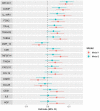Plasma proteomics identifies CRTAC1 as a biomarker for osteoarthritis severity and progression
- PMID: 35924962
- PMCID: PMC9977119
- DOI: 10.1093/rheumatology/keac415
Plasma proteomics identifies CRTAC1 as a biomarker for osteoarthritis severity and progression
Abstract
Objectives: The aim of this study was to identify biomarkers for radiographic OA severity and progression acting within the inflammation and metabolic pathways.
Methods: For 3517 Rotterdam Study participants, 184 plasma protein levels were measured using Olink inflammation and cardiometabolic panels. We studied associations with severity and progression of knee, hip and hand OA and a composite overall OA burden score by multivariable regression models, adjusting for age, sex, cell counts and BMI.
Results: We found 18 significantly associated proteins for overall OA burden, of which 5 stayed significant after multiple testing correction: circulating cartilage acidic protein 1 (CRTAC1), cartilage oligomeric matrix protein (COMP), thrombospondin 4, IL-18 receptor 1 (IL-18R1) and TNF ligand superfamily member 14. These proteins were also associated with progression of knee OA, with the exception of IL-18R1. The strongest association was found for the level of CRTAC1, with 1 s.d. increase in protein level resulting in an increase of 0.09 (95% CI 0.06, 0.12) in the overall OA Kellgren-Lawrence sum score (P = 2.9 × 10-8) in the model adjusted for age, sex, BMI and cell counts. This association was also present with the severity of OA in all three joints and progression of knee OA and was independent of BMI. We observed a stronger association for CRTAC1 with OA than for the well-known OA biomarker COMP.
Conclusion: We identified several compelling biomarkers reflecting the overall OA burden and the increased risk for OA progression. CRTAC1 was the most compelling and robust biomarker for OA severity and progression. Such a biomarker may be used for disease monitoring.
Keywords: biomarkers; inflammation; metabolic pathway; osteoarthritis; progression; severity.
© The Author(s) 2022. Published by Oxford University Press on behalf of the British Society for Rheumatology.
Figures


References
-
- Hunter DJ, March L, Chew M.. Osteoarthritis in 2020 and beyond: a Lancet Commission. Lancet 2020;396:1711–2. - PubMed
-
- Mobasheri A, Rayman MP, Gualillo O. et al. The role of metabolism in the pathogenesis of osteoarthritis. Nat Rev Rheumatol 2017;13:302–11. - PubMed
-
- van Spil WE, Szilagyi IA.. Osteoarthritis year in review 2019: biomarkers (biochemical markers). Osteoarthritis Cartilage 2020;28:296–315. - PubMed
Publication types
MeSH terms
Substances
LinkOut - more resources
Full Text Sources
Research Materials
Miscellaneous

